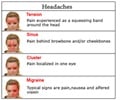Injections of botulinum toxin (BOTOX®) may provide significant relief from hard-to-treat migraines for children and teens.
- One in 10 school-aged children and teens suffer from migraines.
- Currently only one preventative migraine medication, topiramate, is approved for adolescents.
- BOTOX® could provide an alternative for those without treatment options.
Currently, BOTOX® is approved by the U.S. Food and Drug Administration (FDA) only to treat migraines in adults. One in 10 school-aged children and teens suffer from migraines, but there are few FDA-approved medications for this age group. Additionally, some children and teens don't respond well to available options, such as certain migraine "rescue" pain medications, and the pain and disability of migraines can have a severe impact on their lives. In some cases, preventative medications may help. However, currently only one preventative migraine medication, topiramate, is approved for adolescents.
The study included nine children and teens (ages 8 to 17) who suffered from migraines from 8 to 29.5 days per month. Most had tried numerous medications and other therapies without much relief. All received BOTOX® injections in the front and back of the head and neck every 12 weeks and were evaluated over a five-year period. After treatment, the patients experienced migraines 2 to 10 days per month. Additionally, when they did have migraines:
- Their headaches didn't last nearly as long. Patients' migraines lasted 30 minutes to 24 hours before treatment and lasted 15 minutes to 7 hours after treatment with BOTOX®.
- Their headaches weren't as painful. Patient-reported pain on a scale of 1-10 (from no pain to worst pain imaginable) ranged from 4 to 8 before treatment and 1.75 to 5 after treatment with BOTOX®.
Eight adverse events were reported during the study, most were due to pain at the injection site. No severe adverse events were reported.
If the results of the current study are confirmed, BOTOX® could provide an alternative for those without treatment options, said Dr. Shah. Her team currently is enrolling patients to study this treatment in a prospective, randomized double-blinded trial to compare BOTOX® to a placebo.
"Many current migraine medications have side effects including sedation, dry mouth and confusion, which aren't well-tolerated in children and teens," said Dr. Shah. "Our research of BOTOX® is part of an effort to find better treatments for children and teens with migraines so they can realize their full potential."
References:
-
ANESTHESIOLOGY 2017 - (http://www.asahq.org/)










